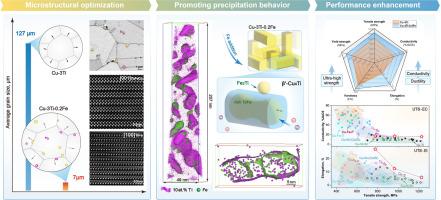通过调节析出相和纳米结构,克服了超高强度Cu-3Ti-0.2Fe合金强度、延展性和导电性之间的平衡
IF 14.3
1区 材料科学
Q1 MATERIALS SCIENCE, MULTIDISCIPLINARY
引用次数: 0
摘要
超高强度Cu-Ti合金被认为是下一代弹性电子元件的理想材料,但在强度、导电性和塑性方面面临关键瓶颈。在本研究中,Ti和Fe元素的协同效应优化了析出行为和纳米结构设计,从而克服了Cu-Ti合金固有的强度-塑性和强度-导电性权衡。微量Fe的加入促进了纳米级β′-Cu4Ti析出相的分散形核,导致强化相的密度显著提高,尺寸显著减小。原子探针层析分析表明,Fe最初与β′-Cu4Ti相共析出,随后从核心向生长尖端分离。Fe原子的富集显著提高了Ti在β′-Cu4Ti相中的扩散能垒,从而促进了残余Ti溶质的充分析出。纳米级球形Fe2Ti相的析出是由于其在β′-Cu4Ti析出相界面处良好的非均相成核。初生Ti2FeCu和TiFe相的形成使Cu-3Ti-0.2Fe合金的晶粒尺寸从127 μm细化到7 μm,加工后进一步细化到310 nm。经过热处理,我们得到了1228 MPa强度的Cu-Ti-Fe合金,其电导率和伸长率分别提高到16.8%和5.5%。β′-Cu4Ti相的均匀纳米晶和增强的析出行为是其综合性能的重要因素。该研究使我们重新评估了这两种电导率有害元素之间的协同效应,并为超高强度Cu-Ti合金的电导率和塑性的发展提供了一种新的加工策略。本文章由计算机程序翻译,如有差异,请以英文原文为准。

Overcoming the trade-off among strength, ductility, and electrical conductivity in an ultra-high strength Cu-3Ti-0.2Fe alloy through regulating precipitates and nanostructures
Ultrahigh-strength Cu-Ti alloys are considered ideal materials for next-generation elastic electronic components, but face a critical bottleneck among the strength, electrical conductivity, and plasticity. Here in this study, the synergistic effect of Ti and Fe elements optimized precipitation behavior and nanostructure design, thereby overcoming the inherent strength-plasticity and strength-conductivity trade-offs in Cu-Ti alloys. Trace Fe additions promote dispersed nucleation of nanoscale β'-Cu4Ti precipitates, leading to a significantly higher density and finer size of the strengthening phase. Atom probe tomography analyses reveal that the Fe initially co-precipitates with the β'-Cu4Ti phase, subsequently segregating from the core toward the growth tips. The enrichment of Fe atoms significantly raises the diffusion energy barrier for Ti within the β'-Cu4Ti phase, thereby facilitating sufficient precipitation of residual Ti solutes. The precipitation of nanoscale spherical Fe2Ti phases is attributed to their favorable heterogeneous nucleation at the interfaces of β'-Cu4Ti precipitates. The formation of primary Ti2FeCu and TiFe phases refines the grain size of Cu-3Ti-0.2Fe alloy from 127 to 7 μm, and further reaches 310 nm after processing. After thermomechanical treatment, we report a 1228 MPa strength Cu-Ti-Fe alloy with improved conductivity and elongation to 16.8 %IACS and 5.5%. The uniform nanocrystalline and the enhanced precipitation behavior of β'-Cu4Ti phases contribute significantly to the comprehensive properties. This study leads us to reevaluate the synergistic effects between these two conductivity-detrimental elements and delivers a novel processing strategy for the development of conductivity and plasticity in ultra-high-strength Cu-Ti alloys.
求助全文
通过发布文献求助,成功后即可免费获取论文全文。
去求助
来源期刊

Journal of Materials Science & Technology
工程技术-材料科学:综合
CiteScore
20.00
自引率
11.00%
发文量
995
审稿时长
13 days
期刊介绍:
Journal of Materials Science & Technology strives to promote global collaboration in the field of materials science and technology. It primarily publishes original research papers, invited review articles, letters, research notes, and summaries of scientific achievements. The journal covers a wide range of materials science and technology topics, including metallic materials, inorganic nonmetallic materials, and composite materials.
 求助内容:
求助内容: 应助结果提醒方式:
应助结果提醒方式:


